Description
Clinical Particulars
THERAPEUTIC INDICATIONS:
Rabezole enteric coated tablets are indicated for the treatment of:
- Active duodenal ulcer
- Active benign gastric ulcer
- Symptomatic erosive or ulcerative gastro-oesophageal reflux disease (GORD).
- Gastro-Oesophageal Reflux Disease Long-term Management (GORD Maintenance)
- Symptomatic treatment of moderate to very severe gastro-oesophageal reflux disease (symptomatic GORD)
- Zollinger-Ellison Syndrome
- In combination with appropriate antibacterial therapeutic regimens for the eradication of Helicobacter pylori in patients with peptic ulcer disease.
POSOLOGY AND METHOD OF ADMINISTRATION: Adults/elderly: Active Duodenal Ulcer and Active Benign Gastric Ulcer: The recommended oral dose for both active duodenal ulcer and active benign gastric ulcer is 20mg to be taken once daily in the morning. Most patients with active duodenal ulcer heal within four weeks. However a few patients may require an additional four weeks of therapy to achieve healing. Most patients with active benign gastric ulcer heal within six weeks. However, again a few patients may require an additional six weeks of therapy to achieve healing. Erosive or Ulcerative Gastro-Oesophageal Reflux Disease (GORD): The recommended oral dose for this condition is 20mg to be taken once daily for four to eight weeks. Gastro-Oesophageal Reflux Disease Long-term Management (GORD Maintenance): For long-term management, a maintenance dose of RABEZOLE 20mg or 10mg once daily can be used depending upon patient response. Symptomatic treatment of moderate to very severe gastro-oesophageal reflux disease (symptomatic GORD): 10mg once daily in patients without oesophagitis. If symptom control has not been achieved during four weeks, the patient should be further investigated. Once symptoms have resolved, subsequent symptom control can be achieved using an on-demand regimen taking 10mg once daily when needed. Zollinger-Ellison Syndrome: The recommended adult starting dose is 60 mg once a day. The dose may be titrated upwards to 120mg/day based on individual patient needs. Single daily doses up to 100mg/day may be given. 120mg dose may require divided doses, 60mg twice daily.
Treatment should continue for as long as clinically indicated. Eradication of H. pylori: Patients with H. pylori infection should be treated with eradication therapy. The following combination given for 7 days is recommended. RABEZOLE 20mg twice daily + clarithromycin 500mg twice daily and amoxicillin 1g twice daily.
For indications requiring once daily treatment RABEZOLE tablets should be taken in the morning, before eating; and although neither the time of day nor food intake was shown to have any effect on rabeprazole sodium activity, this regimen will facilitate treatment compliance. – Patients should be cautioned that the RABEZOLE tablets should not be chewed or crushed, but should be swallowed whole. Renal and hepatic impairment: No dosage adjustment is necessary for patients with renal or hepatic impairment Children: RABEZOLE is not recommended for use in children, as there is no experience of its use in this group.
CONTRA-INDICATION: RABEZOLE is contra-indicated in patients with known hypersensitivity to rabeprazole sodium, substituted benzimidazoles or to any excipient used in the formulation. RABEZOLE is contra-indicated in pregnancy and during breast feeding.
SPECIAL WARNINGS AND PRECAUTIONS FOR USE:
Bone fracture: Several published observational studies suggest that proton pump inhibitor (PPI) therapy may be associated with an increased risk for osteoporosis-related fractures of the hip, wrist, or spine. The risk of fracture was increased in patients who received high dose, defined as multiple daily doses, and long-term PPI therapy (a year or longer). Patients should use the lowest dose and shortest duration of PPI therapy appropriate to the condition being treated. Patients at risk for osteoporosis-related fractures should be managed according to the established treatment guidelines.
- Prescription proton pump inhibitor (PPI) drugs may cause low serum magnesium levels (hypomagnesemia) if taken for prolonged periods of time (in most cases, longer than one year), magnesium supplementation alone did not improve low serum magnesium levels and the PPI had to be discontinued.
- Low serum magnesium levels can result in serious adverse events including muscle spasm (tetany), irregular heartbeat (arrhythmias), and convulsions (seizures); however, patients do not always have these symptoms. Treatment of hypomagnesemia generally requires magnesium supplements. Treatment in patients taking a PPI and who have hypomagnesemia may also require stopping the PPI.
– Symptomatic response to therapy with rabeprazole sodium does not preclude the presence of gastric or oesophageal malignancy, therefore the possibility of malignancy should be excluded prior to commencing treatment with RABEZOLE.
– Patients on long-term treatment (particularly those treated for more than a year) should be kept under regular surveillance.
– A risk of cross-hypersensitivity reactions with other proton pump inhibitor or substituted benzimidazoles cannot be excluded.
Patients should be cautioned that RABEZOLE tablets should not be chewed or crushed, but should be swallowed whole.
RABEZOLE is not recommended for use in children, as there is no experience of its use in this group.
Co-administration of atazanavir with RABEZOLE is not recommended.
Treatment with proton pump inhibitors, including RABEZOLE, may possibly increase the risk of gastrointestinal infections such as Salmonella, Campylobacter and Clostridium difficile.
INTERACTIONS WITH OTHER MEDICAMENTS AND OTHER FORMS OF INTERACTION: -Rabeprazole sodium, as is the case with other members of the proton pump inhibitor (PPI) class of compounds, is metabolized through the cytochrome P450 (CYP450) hepatic drug metabolizing system.
-Rabeprazole sodium produces a profound and long lasting inhibition of gastric acid secretion. An interaction with compounds whose absorption is pH dependent may occur; therefore the potential for such interaction was investigated. Co-administration of rabeprazole sodium results in a 33% decrease in ketoconazole levels and a 22% increase in trough digoxin levels in normal subjects. Therefore individual patients may need to be monitored to determine if a dosage adjustment is necessary when such drugs are taken concomitantly with RABEZOLE.
-There was no clinically relevant interaction with food.
-No interaction is expected between rabeprazole and cyclosporin.
PREGNANCY AND LACTATION:
-There are no data on the safety of rabeprazole in human pregnancy. No evidence of impaired fertility or harm to the foetus due to rabeprazole sodium. RABEZOLE is contraindicated during pregnancy. –It is not known whether rabeprazole sodium is excreted in human breast milk. RABEZOLE should not be used during breast feeding.
EFFECTS ON ABILITY TO DRIVE AND USE MACHINES: Based on the pharmacodynamic properties and the adverse events profile, it is unlikely that RABEZOLE would cause an impairment of driving performance or compromise the ability to use machinery. If however, alertness is impaired due to somnolence, it is recommended that driving and operating complex machinery be avoided.
UNDESIRABLE EFFECTS: The most commonly adverse drug reactions with rabeprazole are headache, diarrhoea, abdominal pain, asthenia, flatulence, rash and dry mouth.
| System Organ Class | Common | Uncommon | Rare | Very Rare | Not Known |
| Infections and infestations | Infection | ||||
| Blood and the lymphatic system disorders | Neutropenia
Leucopenia Thrombocytopenia Leucocytosis |
||||
| Immune system disorders | Hypersensitivity1,2 | ||||
| Metabolism and nutrition disorders | Anorexia | Hyponatremia | |||
| Psychiatric disorders | Insomnia | Nervousness | Depression | Confusion | |
| Nervous system disorders | Headache
Dizziness |
Somnolence | |||
| Eye disorders | Visual disturbance | ||||
| Vascular disorders | Peripheral oedema | ||||
| Respiratory, thoracic and mediastinal disorders | Cough
Pharyngitis Rhinitis |
Bronchitis
Sinusitis |
|||
| Gastrointestinal disorders | Diarrhoea
Vomiting Nausea Abdominal pain Constipation Flatulence |
Dyspepsia
Dry mouth Eructation |
Gastritis
Stomatitis Taste disturbance |
||
| Hepato-biliary disorders | Hepatitis
Jaundice Hepatic encephalopathy3 |
||||
| Skin and subcutaneous tissue disorders | Rash
Erythema2 |
Pruritus
Sweating Bullous reactions2 |
Erythema multiforme, toxic epidermal necrolysis (TEN), Stevens-Johnson syndrome (SJS) | ||
| Musculoskeletal, connective tissue and bone disorders | Non-specific pain
Back pain |
Myalgia
Leg cramps Arthralgia |
|||
| Renal and urinary disorders | Urinary tract infection | Interstitial nephritis | |||
| Reproductive system and breast disorders | Gynaecomastia | ||||
| General disorders and administration site conditions | Asthenia
Influenza like illness |
Chest pain
Chills Pyrexia |
|||
| Investigations | Increased hepatic enzymes3 | Weight increased |
1 Includes facial swelling, hypotension and dyspnoea
2 Erythema, bullous reactions and hypersensitivity reactions have usually resolved after discontinuation of therapy.
3 Rare hepatic encephalopathy in patients with underlying cirrhosis. In treatment of patients with severe hepatic dysfunction the prescriber is advised to exercise caution when treatment with RABEZOLE is first initiated in such patients.
Post marketing reports: Musculoskeletal: Bone fracture
OVERDOSE: Symptoms: Deliberate or accidental overdose is limited. The maximum established exposure has not exceeded 60mg twice daily, or 160mg once daily. Effects are generally minimal, representative of the known adverse event profile and reversible without further medical intervention. Treatment: No specific antidote is known. Rabeprazole sodium is extensively protein bound and is, therefore, not readily dialysable. As in any case of overdose, treatment should be symptomatic and general supportive measures should be utilised.
PHARMACOLOGICAL PROPERTIES: Pharmacodynamic properties Mechanism of Action: Rabeprazole sodium belongs to the class of anti-secretory compounds, the substituted benzimidazoles, that do not exhibit anticholinergic or H2 histamine antagonist properties, but suppress gastric acid secretion by the specific inhibition of the H+/K+-ATPase enzyme (the acid or proton pump). The effect is dose-related and leads to inhibition of both basal and stimulated acid secretion irrespective of the stimulus. Rabeprazole sodium rapidly disappears from both the plasma and gastric mucosa. As a weak base, rabeprazole is rapidly absorbed following all doses and is concentrated in the acid environment of the parietal cells. Rabeprazole is converted to the active sulphenamide form through protonation and it subsequently reacts with the available cysteines on the proton pump.
Anti-secretory Activity: -After oral administration of a 20mg dose of rabeprazole sodium the onset of the anti-secretory effect occurs within one hour, with the maximum effect occurring within two to four hours. Inhibition of basal and food stimulated acid secretion 23 hours after the first dose of rabeprazole sodium are 69% and 82% respectively and the duration of inhibition lasts up to 48 hours. The inhibitory effect of rabeprazole sodium on acid secretion increases slightly with repeated once-daily dosing, achieving steady state inhibition after three days. When the drug is discontinued, secretory activity normalises over 2 to 3 days. -Helicobacter pylori is associated with acid peptic disease including duodenal ulcer (DU) and gastric ulcer (GU). H. pylori is implicated as a major contributing factor in the development of gastritis and ulcers in such patients. Recent evidence also suggests a causative link between H. pylori and gastric carcinoma. -Eradication of H. pylori with RABEZOLE (rabeprazole) and antimicrobials is associated with high rates of healing of mucosal lesions. Rabeprazole 20 mg twice daily in combination with two antibiotics e.g. clarithromycin and amoxicillin or clarithromycin and metronidazole (given at approved dose levels) for 1 week achieve > 80% H. pylori eradication rate in patients with gastro-duodenal ulcers. Local information on the prevalence of resistance and local therapeutic guidelines should be taken in account in the choice of an appropriate combination regimen for H. pylori eradication therapy. Further more, in patients with persistent infection, potential development of secondary resistance (in patients with primary-susceptible strains) to an antibacterial agent should be taken into account in the considerations for a new re-treatment regimen.
Serum Gastrin Effects: No significant change.
Other Effects: Rabeprazole sodium, given in oral doses of 20mg for 2 weeks, had no effect on thyroid function, carbohydrate metabolism, or circulating levels of parathyroid hormone, cortisol, oestrogen, testosterone, prolactin, cholecystokinin, secretin, glucagon, follicle stimulating hormone (FSH), luteinising hormone (LH), renin, aldosterone or somatotrophic hormone.
Pharmacokinetic properties Absorption: RABEZOLE is an enteric-coated (gastro-resistant) tablet formulation of rabeprazole sodium. This presentation is necessary because rabeprazole is acid-labile. Absorption of rabeprazole therefore begins only after the tablet leaves the stomach. Absorption is rapid, with peak plasma levels of rabeprazole occurring approximately 3.5 hours after a 20mg dose. Peak plasma concentrations (Cmax) of rabeprazole and AUC are linear over the dose range of 10mg to 40mg. Absolute bioavailability of an oral 20mg dose (compared to intravenous administration) is about 52% due in large part to pre-systemic metabolism. Additionally the bioavailability does not appear to increase with repeat administration. In healthy subjects the plasma half-life is approximately one hour (range 0.7 to 1.5 hours), and the total body clearance is estimated to be 283 ± 98 ml/min. Neither food nor the time of day of administration of the treatment affect the absorption of rabeprazole sodium.
Distribution: Rabeprazole is approximately 97% bound to human plasma proteins.
Metabolism and excretion: -In humans the thioether (M1) and carboxylic acid (M6) are the main plasma metabolites with the sulphone (M2), desmethyl-thioether (M4) and mercapturic acid conjugate (M5) minor metabolites observed at lower levels. Only the desmethyl metabolite (M3) has a small amount of anti-secretory activity, but it is not present in plasma. -Following a single 20mg 14C labelled oral dose of rabeprazole sodium, no unchanged drug was excreted in the urine. Approximately 90% of the dose was eliminated in urine mainly as the two metabolites: a mercapturic acid conjugate (M5) and a carboxylic acid (M6), plus two unknown metabolites. The remainder of the dose was recovered in faeces.
Gender: Adjusted for body mass and height, there are no significant gender differences in pharmacokinetic parameters following a single 20mg dose of rabeprazole.
Renal dysfunction: The clearance of the drug in patients with renal disease requiring maintenance haemodialysis was approximately twice that in healthy subjects.
Hepatic dysfunction: The half-life of rabeprazole in patients with hepatic impairment was 12.3 hours compared to 2.1 hours in healthy subjects.
Elderly: Elimination of rabeprazole was somewhat decreased in the elderly. However there was no evidence of rabeprazole accumulation.
PACKING:
RABEZOLE 10 mg: A box containing 7 tablets in PVDC/Al strip and a pamphlet.
RABEZOLE 20 mg: A box containing 7 tablets in PVDC/Al strip and a pamphlet.
STORAGE:
Keep at a temperature not exceeding 30°C, in dry place.
Keep out of reach of children.


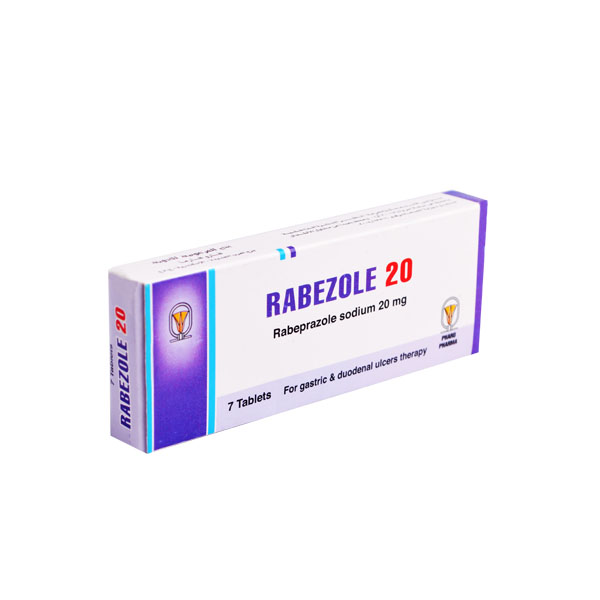


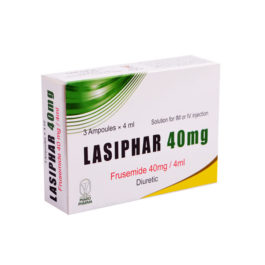

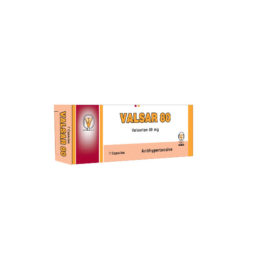
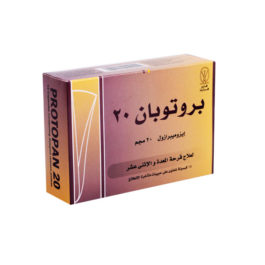
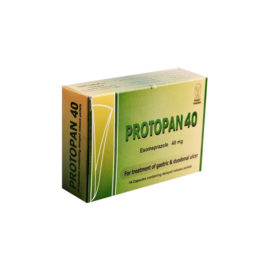
Reviews
There are no reviews yet.